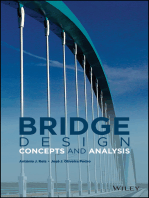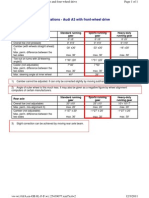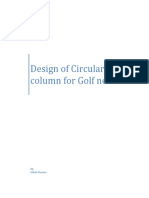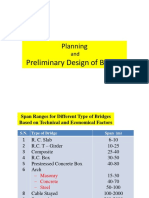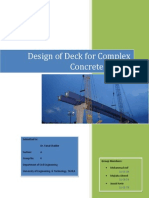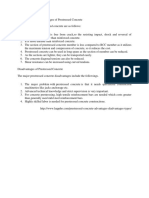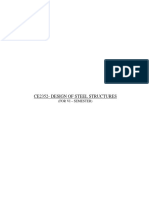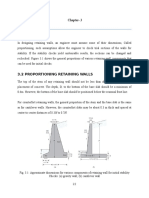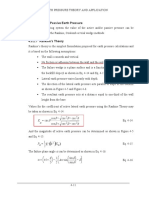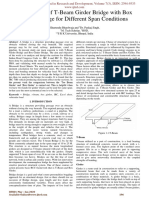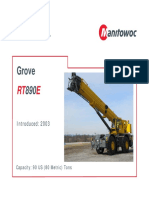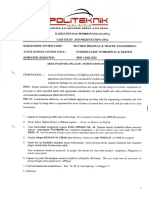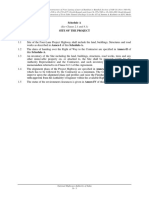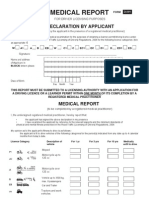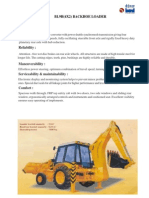Design Example RC Slab PDF
Design Example RC Slab PDF
Uploaded by
nabinniraulaCopyright:
Available Formats
Design Example RC Slab PDF
Design Example RC Slab PDF
Uploaded by
nabinniraulaOriginal Description:
Original Title
Copyright
Available Formats
Share this document
Did you find this document useful?
Is this content inappropriate?
Copyright:
Available Formats
Design Example RC Slab PDF
Design Example RC Slab PDF
Uploaded by
nabinniraulaCopyright:
Available Formats
Design Example of Design of RC Slab Bridge
Problem Statement and Owner Requirements
Design a Bridge Deck to meet the following requirements of owner.
Type of Bridge : Local Road Bridge
Bridge Clear Span :6m
Carriage Way : Two Lane
Foot Path : Two (Each on either side of bridge)
Wearing Course : Asphalt Concrete
Height of Support :7m
Design of Bridge Deck
Design of bridge deck has been carried out in the following steps.
I. Planning and Preliminary Design of Deck
Bridge deck design is started with the appropriate selection of bridge deck type. Then
geometry of the deck is planned, type of materials required for deck are decided.
(Refer IRC 5 and IRC 6 for planning and preliminary design)
II. Analysis of Bridge Deck
In the analysis, loads on bridge deck are assessed, critical responses of bridge deck i.e.
maximum values of longitudinal bending moment, and longitudinal shear force and
transverse bending moment at the critical sections of deck slab are calculated.
(Refer IRC 6 for analysis of bridge deck)
III. Design and Detailing of Bridge Deck
In this stage, critical section of deck slab is designed for different responses. Sizes of the
component of Slab Bridge is verified, find quantity of reinforcing bars and their
arrangements. After design, detailing of reinforcing bars is carried out.
(Refer IRC 21 and IRC 112, IS456, SP16 and SP34 for RC design and detailing)
Design Example of RC Slab Bridge Page 1
Prepared by NC Sharma
I. Planning and Preliminary Design of Bridge Deck
A. Selection of Type of Bridge Deck
For bridges up to 8 m span, slab type of bridge will be technically and economically feasible.
So for 6 m span, slab type deck is appropriate and has been selected.
B. Material Selection
Take
M25 grade of concrete for all RC work
Fe 415 HYSD bars for all RC work
Asphalt Concrete for Wearing Coat
Heavy Steel Pipe of Mild Steel for Railing
C. Geometry of Bridge Deck
Depth of Slab
Follow deflection control criterion to determine the depth of slab.
Take
𝑆𝑝𝑎𝑛
= 13
𝑑
6.4
∴𝑑= = 0.492; Adopt Overall Depth of Slab (D) = 550 mm
13
Effective Depth of slab (d) = Overall Depth – Concrete Cover – Dia. Of bar/2
= 550 – 40 – 20/2
= 500 mm
Where,
Effective Span of bridge = Clear Span + Bearing Width (or Clear Span + d) = 6.4 m
Min. Bearing Width of bridge = 305 + 2.5L + 10H mm [Refer 219.9 IRC 6-2010]
= 390 mm Where, L= 6m and H = 7m
Adopt bearing width of slab = 400 mm
Minimum clear cover to main reinforcing bar = 40 mm [Refer IRC 21]
𝑆𝑝𝑎𝑛
Usually ratio for RC solid slab bridge is taken 12 to 15.
𝑑
Width of Carriageway and Foot Path
Take, Width of carriageway =7.5 m, Width of footpath = 1 m, Height of footpath = 0.3 m
Minimum carriageway width for double lane bridge = 7 m
Minimum width of footway = 0.6 m
Minimum raised height of footway from wearing course = 0.225 m [Refer IRC 5]
Design Example of RC Slab Bridge Page 2
Prepared by NC Sharma
Type of Railing
Provide heavy steel pipe with RC post as railing.
Take
RC post of 225 mm × 225 mm × 1100 mm
No of Post = 5 on either side of bridge
Spacing of post = 1.6 m for intermediate posts and 1.68 m for end posts
3 - 48.3 mm ∅ heavy steel pipe @ 4.37 kg per running meter [Refer steel section book]
48.3 mm dia. steel pipe
0.1 m
0.4 m
1.1 m
Fig: Railing
0.4 m
0.4 m
0.225 m
Type of Drainage Spout
Take Standard type of drainage spout with 100 mm dia. drainage pipe
Provide drainage spout @ 3.4 m c/c
Type of Wearing Coat [Refer 1308, Yellow Book]
Take Asphalt Concrete for wearing coat of bridge. Thickness of wearing coat is taken 50 mm
at edge and 110 mm at mid of carriage way to give about 2.5% camber.
Length of Bridge
Length of bridge = span of bridge + bearing width = 6.4 + 0.4 = 6.8 m
Design Example of RC Slab Bridge Page 3
Prepared by NC Sharma
Transverse Section
of Bridge at A-A
Asphalt concrete of 50 mm th. at
edge and 110 mm th. at crown
B
1.1 m
7.5 m RC post of 225 mm × 225 mm
with three heavy steel pipes
0.55m
9.5 m
RC foot path of 1m width
and 0.3 m height
B
Longitudinal Section
of Bridge at B-B
RC foot path of 1 m width RC posts with 1.6 m
and 0.3 m height spacing for intermediate
and 1.68 m spacing for end
posts
0.55 m
6.4 m
L = 6.8 m
A
Design Example of RC Slab Bridge Page 4
Prepared by NC Sharma
II. Analysis of Bridge Deck
Normally slab is analyzed and designed for one meter strip. So in this example load and
responses of slab have been calculated for one meter strip of deck slab.
Dead Load Calculation
Take self-weight of RC slab and wearing coat as dead loads for middle strip of slab.
Design load due to self-weight of slab and wearing course for one meter strip (𝑤𝑢 )
= 𝐷𝑠 𝛾𝑅𝐶 𝑟𝑓 𝐷𝐿 + 𝐷𝑤𝑐 𝛾𝑤𝑐 𝑟𝑓 𝑤𝑐 = 0.55 × 25 × 1.35 + 0.08 × 22 × 1.75 = 21.65 𝐾𝑁/𝑚
wu = 21.65KN / m
6.4 m
Where,
Unit weight of reinforced concrete 𝛾𝑅𝐶 =25 KN/m3
Unit weight of Asphalt concrete (wearing coat) 𝛾𝑤𝑐 =22 KN/m3
Partial safety factor for DL (slab) 𝑟𝑓 𝐷𝐿 = 1.35
Partial safety factor for wearing coat 𝑟𝑓 𝑤𝑐 = 1.75
Average depth for wearing course 𝐷𝑤𝑐 = (0.11 + 0.05)/2 = 0.08 m
[For partial safety factor for load refer IRC 6 -2010]
Live Load Calculation
According to IRC 6 -2010 Table 2, following live load shall be considered for two Lane Bridge.
Two lane of class A load as normal load
Or
One lane of class AA load (tracked and wheeled ) as abnormal load
In the case of abnormal load in local road bridge, Class AA load is recommended for
analysis instead of IRC 70R load.
Partial safety factor for live load 𝑟𝑓 𝐿𝐿 = 1.5
Design Example of RC Slab Bridge Page 5
Prepared by NC Sharma
Impact Factor Fraction for different Loadings
According to IRC 6-2010 Cl. 208.2
4.5 4.5
a. For Class A IFF = = = 0.363
6+𝐿 6+6.4
b. For Class AA (tracked) IFF = 0.25 for 5 m span
IFF = 0.10 for 9 m span
IFF = 0.1975 for 6.4m span
c. For Class AA (wheeled) IFF = 0.25 for span < 9m
Calculation of maximum longitudinal bending moment (LBM) at critical section of bridge deck
Longitudinal bending moment is maximum at mid span of slab. So in this example, LBM due to
dead load and live load have been calculated for mid span of slab.
1. Maximum LBM due to DL at mid span
𝑊𝑢 × 𝐿2
Maximum LBM at mid span = = 21.65 × 6.42/8 = 110.85 KN-m
8
2. Maximum LBM due to LL at mid span
Find LBM due to Class A load, Class AA tracked load and Class AA wheeled load at mid
span. Maximum value of LBM is taken for design.
LBM due to class A loading
Position two trains of Class A load transversely at maximum eccentricity from the
center of deck maintaining minimum clearance from footpath.
Take minimum clearance from footpath for class A load = 0.15 m and clear distance
between two trains of Class A load = 1.2 m
Position Class A train longitudinally to give maximum LBM at mid span. In 6.4 m span
maximum loaded axles of Class A load is placed symmetrically with respect to mid
span of bridge to get maximum LBM at mid span.
Longitudinal dispersion of the Class A load has not been considered in the example
Design Example of RC Slab Bridge Page 6
Prepared by NC Sharma
Load from 114 KN axle of Class A load
2.6 m 1.2 m
m
Axle I Axle II
L = 6.4 m
Longitudinal position of Class A load
1 m 0.4 m 1.8 m 1.7 m 1.8 m
0.5 m
B = 9.5 m
Transverse positioning of Class A load [Two trains]
Find effective width (bef) of a wheel of Class A load [Refer IRC 21-2000 Cl. 305.16.2]
𝑎 2.6
bef = 𝛼 × 𝑎 1 − + 𝑏1 = 2.83 × 2.6 1 − + 0.66 = 5.03 m
𝑙 6.4
𝐵 9.5
𝑊ℎ𝑒𝑟𝑒, 𝑎 = 2.6 m, l = 6.4 m, b1 = 0.08 × 2 + 0.5 = 0.66 m, 𝛼 = 2.83 𝑓𝑜𝑟 = = 1.484
𝑙 6.4
Since the bef of individual wheel overlaps, find modified effective width for all wheels of axle I
and axle II.
𝑏 𝑒𝑓
bef 𝑚𝑜𝑑 = bef 𝑚𝑜𝑑 𝐼 = bef 𝑚𝑜𝑑 𝐼𝐼
= 1 + 0.4 + 1.8 + 1.7 + 1.8 + = 9.125 < 𝐵 = 9.5 𝑚
2
Hence, Adopt bef 𝑚𝑜𝑑 = 9.215 𝑚
2 × 114 × 𝐼𝐹 × 𝛾𝐿𝐿
𝑓 2 × 114 × 1.363 × 1.5
Load per unit width of slab = 𝑚𝑜𝑑 = = 50.6 KN/m
b ef 9.215
Maximum LBM at mid span = 50.6 × 3.2 - 50.6 × 0.6 = 131.6 KN-m
Design Example of RC Slab Bridge Page 7
Prepared by NC Sharma
LBM due to Class AA (T) load at mid span
Position a set of Class AA (T) load transversely at maximum eccentricity from the
center of deck maintaining minimum clearance from footpath.
Take minimum clearance from footpath for class AA load in two lane bridge 1.2 m
Position Class AA (T) longitudinally to give maximum LBM at mid span. Symmetrical
placement of track at mid span gives maximum LBM.
Consider Longitudinal dispersion of track load (along span)
Ldis = 3.6 +2 × (D + h) = 3.6 + 2 × (0.55 + 0.08) = 4.86 m
4.86 m
a = 3.2 m
I = 6.4 m
Longitudinal positioning of Class AA (T)
1.625m
1m 1.2m 1.2m
0.85 m 0.85 m
B = 9.5m
Transverse positioning of Class AA (T)
Find effective width (bef) of individual track [Refer IRC 21-2000 Cl. 305.16.2]
𝑎 3.2
bef = 𝛼 × 𝑎 1 − + 𝑏1 = 2.83 × 3.2 1 − 6.4 + 1.01 = 5.538 m
𝑙
Where a = 3.2 m, l = 6.4 m, b1 = 0.08 × 2 + 0.85 = 1.01 m, 𝛼 = 2.83 for B/L = 1.484
Since the bef of individual track overlaps, find modified effective width for two tracks.
𝑚𝑜𝑑
𝑏𝑒𝑓 = 1 + 1.625 + 2.05 + bef /2 = 7.44 m < B = 9.5 m
𝑚𝑜𝑑
Adopt 𝑏𝑒𝑓 = 7.44 𝑚
700 × 𝐼𝐹 × 𝑟 𝑓 𝐿𝐿 700 × 1.1975 × 1.5
Load per unit width = 𝑚𝑜𝑑 = = 34.77 KN/m
b 𝑒𝑓 × 𝐿𝑑𝑖𝑠 7.44 × 4.86
700 × 1.1975 × 1.5
Maximum LBM at mid span = × 3.2 - 34.77 × 4.86/2 × 4.86/4 = 167.75 KN-m
7.44 × 2
Design Example of RC Slab Bridge Page 8
Prepared by NC Sharma
LBM due to Class AA (W) at mid span
Position a set of Class AA (W) load transversely at maximum eccentricity from the
center of deck maintaining minimum clearance from footpath.
Take minimum clearance from footpath for class AA load in two lane bridge 1.2 m
Position Class AA (W) longitudinally to give maximum LBM at mid span. Symmetrical
placement of two axle at mid span gives maximum LBM.
Longitudinal dispersion of load has not been considered in the example
Load from 200 KN axle of Class AA (W) load
a = 2.6 m 1.2 m
m
Axle I Axle II
l = 6.4 m
Longitudinal position of Class AA (W) load
1m 1.2 m 0.6 m 1m 0.6 m
0.3 m
B = 9.5 m
Transverse positioning of Class AA (W) load
Find effective width (bef) of individual track [Refer IRC 21-2000 Cl. 305.16.2]
𝑎 2.6
bef = 𝛼 × 𝑎 1 − + 𝑏1 = 2.83 × 2.6 1 − 6.4 + 0.46 = 4.829 m
𝑙
Where a = 2.6m, l = 6.4 m, b1 = 0.08 × 2 + 0.3 = 0.46 m, 𝛼 = 2.83 for B/l = 1.484
Since the bef of individual wheel overlaps, find modified effective width for all wheels of
individual axle of Class AA (W)
0.3 𝑏𝑒𝑓
bef 𝑚𝑜𝑑 𝐼 = bef 𝑚𝑜𝑑 𝐼𝐼 = 1 + 1.2 + + 0.6 + 1 + 0.6 + = 6.96 𝑚 < 𝐵 = 9.5 𝑚
2 2
Adopt bef 𝑚𝑜𝑑 = 6.96 𝑚
200 × 𝐼𝐹 × 𝑟 𝑓 𝐿𝐿 200 × 1.25 × 1.5
Load per unit width = = = 53.88 KN/m
bef 𝑚𝑜𝑑 6.96
Maximum LBM at mid span = 53.88 × 3.2 - 53.88 × 0.6 = 140.1 KN-m
Design Example of RC Slab Bridge Page 9
Prepared by NC Sharma
Calculation of maximum longitudinal shear force (LSF) at critical section of bridge deck
LSF is maximum at support of slab. So in this example, LSF due to dead load and live load have
been calculated for support of slab.
1. Maximum LSF due to DL at support
𝑤𝑢 × 𝑙
Maximum LBM at mid span = = 21.65 × 6.4/2 = 69.3 KN/m
2
wu = 21.65KN /
m
6.4 m
2. Maximum LSF due to LL at support
Find LSF due to Class A load, Class AA tracked load and Class AA wheeled load at support.
Maximum value of LSF is taken for design.
LSF due to class A loading
Position two trains of Class A load transversely at maximum eccentricity from the
center of deck maintaining minimum clearance from footpath. [Ref. LBM due to Class A]
Take minimum clearance from footpath for class A load = 0.15 m and clear distance
between two trains of Class A load = 1.2 m
Position Class A train longitudinally in such a way so that dispersion of wheels of axle I
will not go beyond the face of support.
Longitudinal dispersion of the Class A load has not been considered in the example
Load from 114 KN axle of Class A load
0.955 m 1.2 m
mm
Axle I Axle II
L = 6.4 m
Longitudinal position of Class A load
Design Example of RC Slab Bridge Page 10
Prepared by NC Sharma
Find effective width (bef) of individual wheel of axle I and axle II
𝑏𝑒𝑓 𝐼 = 2.83 × 0.955 × (1- 0.955/ 6.4) + 0.66
= 2.95 m
𝑏𝑒𝑓 𝐼𝐼 = 2.83 × 2.155 × (1- 2.155/ 6.4) + 0.66
= 4.70 m
Where, a1= 0.2 + 0.5 × (0.25 + 2 × (0.55 + 0.08)) = 0.955m for axle I
a2= a1 + 1.2 =2.155m for axle II
l = 6.4 m
b1 = 0.08 × 2 + 0.5 =0.66 m
𝛼 = 2.83 for B/l =9.5/6.4 =1.484 (for simply supported slab)
Since the bef of individual wheel overlaps, find modified effective width for all wheels of
each axle.
𝑚𝑜𝑑 𝐼 𝑏 𝑒𝑓 𝐼
𝑏𝑒𝑓 =1 + 0.4 + 1.8 + 1.7 + 1.8 + 2
= 8.17 m < B = 9.5 m
𝑚𝑜𝑑 𝐼
Hence, 𝑏𝑒𝑓 = 8.17 𝑚
2×114×𝐼𝐹×𝑟 𝑓 𝐿𝐿 2×114×1.363×1.5
Load per unit width = = = 57.06 KN/m
𝑏𝑚𝑜𝑑
𝑒𝑓
𝐼
8.17
Similarly,
𝑚𝑜𝑑 𝐼𝐼
𝑏𝑒𝑓 =1 + 0.4 + 1.8 + 1.7 + 1.8 + 𝑏𝑒𝑓 𝐼𝐼 / 2
= 9.05 m < B = 9.5 m
𝑚𝑜𝑑 𝐼𝐼
Hence, 𝑏𝑒𝑓 = 8.17 𝑚
2×114×𝐼𝐹×𝑟 𝑓 𝐿𝐿 2×114×1.363×1.5
Load per unit width = 𝑚𝑜𝑑 𝐼𝐼 = = 51.51 KN/m
𝑏𝑒𝑓 9.05
S.F. at support VA
VA × 6.4 = 57.06 × (6.4 - 0.955) + 51.51 × (6.4 - 2.155)
∴ VA = 82.71 KN
Maximum LSF due to class AA (W)
Transverse positioning of Class AA (W) is same as in LBM
Longitudinal positioning of Class AA (W) is done in such a way so that dispersion of
wheels of axle I will not go beyond the face of support (bearing).
Longitudinal dispersion is not considered for calculation of S.F.
Design Example of RC Slab Bridge Page 11
Prepared by NC Sharma
Load from 200 KN axle of Class AA (W) load
a1 = 0.905 m
1.2 m
mm
Axle I Axle II
l = 6.4 m
Longitudinal position of Class AA (W) load
Find effective width (bef) of individual wheel
𝑏𝑒𝑓 𝐼 = 2.83 × 0.905(1 - 0.905/ 6.4) + 0.46
= 2.65 m
𝑏𝑒𝑓 𝐼𝐼= 2.83 ×2.105(1 - 2.105/ 6.4) + 0.46
= 4.45 m
Where a1= 0.2 + 0.5 × (0.15 + 2 × (0.55 + 0.08)) = 0.905 m
a2= a1 + 1.2 =2.105m
l = 6.4 m
b1 = 0.08 × 2 + 0.3 =0.46 m
𝛼 = 2.83 for B/l = 9.5/6.4 = 1.484 (for simply supported slab)
Since the bef of individual wheel overlaps, find modified effective width for all wheels of each
axle.
𝑚𝑜𝑑
𝑏𝑒𝑓 𝐼
=1 + 1.35 + 0.6 + 1 + 0.6 + 𝑏𝑒𝑓 𝐼 /2 = 5.875 m < B = 9.5 m
𝑚𝑜𝑑 𝐼
Hence, 𝑏𝑒𝑓 = 5.875 𝑚
200×𝐼𝐹×𝑟 𝑓 𝐿𝐿 200×1.25×1.5
Load per unit width = 𝑚𝑜𝑑 𝐼 = = 63.83 KN
𝑏𝑒𝑓 5.875
Similarly,
𝑚𝑜𝑑
𝑏𝑒𝑓 𝐼𝐼
=1 + 1.35 + 0.6 + 1 + 0.6 + 𝑏𝑒𝑓 𝐼𝐼 /2 = 6.77 m < B = 9.5 m
𝑚𝑜𝑑 𝐼𝐼
Hence, 𝑏𝑒𝑓 = 6.77 𝑚
200×𝐼𝐹×𝑟 𝑓 𝐿𝐿 200×1.25×1.5
Load per unit width = = = 55.39 KN/m
𝑏𝑚𝑜𝑑
𝑒𝑓
𝐼𝐼 6.77
S.F. at support VA
VA × 6.4 = 63.83 × (6.4 - 0.905) + 51.51 × (6.4 - 2.105)
∴ VA = 89.37 KN
Design Example of RC Slab Bridge Page 12
Prepared by NC Sharma
Maximum LSF due to class AA (T)
Transverse positioning of Class AA (T) is same as in LBM.
Longitudinal positioning of Class AA (T) is done in such a way so that dispersion of
track will not go beyond the face of support (bearing).
Longitudinal dispersion of tracked load is considered for calculation of S.F.
4.86 m
a = 2.63 m
m I = 6.4 m
Longitudinal positioning of Class AA (T)
Find effective width (bef) of a track
bef = 2.83 × 2.63 (1- 2.63/ 6.4) + 1.01
= 5.39 m
Where, a = 0.2 + (3.6 + 2 × (0.55 + 0.08))/2 =2.63m
l = 6.4 m, b1 = 0.08 × 2 + 0.85 = 1.01 m, 𝛼 = 2.83 For B/l =9.5/6.4 =1.484
Since the bef of tracks overlap, find modified effective width.
𝑚𝑜𝑑
𝑏𝑒𝑓 = 1 + 1.2 + 0.85/2 + 2.05 + bef/2 = 7.37 m < B = 9.5 m
𝑚𝑜𝑑
Hence, 𝑏𝑒𝑓 = 7.37 𝑚
700×𝐼𝐹 × 𝑟 𝑓 𝐿𝐿 700×1.1975×1.5
Load per unit width = 𝑚𝑜𝑑 = = 35.11 KN/m
𝑏𝑒𝑓 × 𝐿𝑑𝑖𝑠 7.37×4.86
S.F. at A
VA × 6.4 = 35.11 × 4.86 × (6.4 - 2.63)
∴VA = 100.52 KN
Calculation of maximum transverse bending moment (TBM) at mid of mid span of Slab Deck
Transverse bending moment of slab deck per unit width has been calculated according to IRC
21-2000 Cl. 305.18.1
Maximum TBM at mid of mid span = 0.3 × Max. LBM due to LL + 0.2 × Max. LBM due to DL
= 0.3 × 167.8 + 0.2 × 110.85
= 72.51 KN-m
Design Example of RC Slab Bridge Page 13
Prepared by NC Sharma
Design Responses
Design LBM due to dead load and live load at mid span of slab deck per one meter strip
= 110.85 + 167.8 = 278.65 KN-m /m
Design LSF due to dead load and live load at support of slab deck per one meter strip
= 69.3 + 100.52 = 169.82 KN/m/m
Design TBM due to dead load and live load at mid of mid span of slab deck per one meter
strip = 72.51 KN-m/m
III. Design
1. Design of Deck Slab
Mid section of deck slab has been designed for maximum bending moment due to
dead load and live load and section at support has been designed for maximum
shear force due to dead load and live load.
Reinforcing bars have been found for longitudinal and transverse bending moment
and depth of slab has been verified for longitudinal shear force.
Deck slab has been designed at limit state of collapse and checked at limit state of
serviceability.
i. Design of Deck Slab for Bending
Design Section of deck slab
1000 mm
Take
Clear cover to bar = 40mm
Dia of Long. Bar = 20mm D = 550 mm d = 500 mm
Dia of Tran. Bar = 12mm
Design Section
d (Log. Bar) = 550 – 40 – 20/2 = 500 mm
d (Tr. Bar)
Check depth of =slab
550 – 40 – 20 -12/2 = 484 mm
𝑀𝑢 278.65 × 10 6
𝑑𝑏𝑎𝑙 = = = 284.2 mm
𝑄×𝑏 3.45×1000
Design Example of RC Slab Bridge Page 14
Prepared by NC Sharma
Where, Q = 0.36 fck× 0.48 × (1 - 0.416 × 0.48) = 3.45
Since, 𝑑𝑏𝑎𝑙 < 𝑑, design slab section as SR URS
Find reinforcing bars
Find the area of steel by using table of SP 16.
a. Longitudinal Reinforcement
𝑀𝑢
Find
𝑏𝑑 2
𝑀𝑢 278.65 × 10 6
= = 1.115 ≅ 1.15
𝑏×𝑑 2 1000×500 2
From table, pt= 0.338 % for fck= 25N/mm2 and fy= 415 N/mm2,
0.338
𝐴𝑟𝑒𝑞
𝑠𝑡 = × 1000 × 500 = 1690 mm2
100
Adopt 6 - 20 mm ∅ bar; 𝐴𝑝𝑟𝑜𝑣
𝑠𝑡 = 1885 mm2
Provide 20 mm ∅ @ 167 mm c/c
b. Transverse Reinforcement
𝑀𝑢 72.51 × 10 6
= =0.3095 ≅ 0.35
𝑏×𝑑 2 1000 × 484 2
From table, pt = 0.099 % < 0.12 %; Adopt pt = 𝑝𝑡𝑚𝑖𝑛 = 0.12 % of bD
𝑟𝑒𝑞 0.12
𝐴𝑠𝑡 = 100 × 1000 × 550 = 660 mm2
Adopt 6 - 12 mm ∅ bar; 𝐴𝑝𝑟𝑜𝑣
𝑠𝑡 = 678 mm2
Provide 12 mm ∅ @ 167 mm c/c
c. Temperature Reinforcement
Provide 250 mm2 steel bars per m width as temperature reinforcements in both
direction of slab. [Refer IRC 21- 2000 Cl. 305.10]
Provide 12 mm ∅ bar @ 300mm c/c
ii. Design of Deck Slab for Shear
Check 𝝉𝒖𝒗 ≤ K 𝝉𝒖𝒄
Design Example of RC Slab Bridge Page 15
Prepared by NC Sharma
Where,
𝑉𝑢 169.82×1000
Nominal Shear Stress 𝜏𝑢𝑣 = = = 0.34 N/mm2
𝑏𝑑 1000 ×500
Shear strength of concrete section 𝜏𝑢𝑐 = 0.406N/mm2 for M25 and pt = 0.338 %,
Limiting value of Shear Stress 𝜏𝑢𝑐 ,𝑚𝑎𝑥 = 3.1 N/mm2 [Refer IS 456 table 19, 20]
Depth factor (K) =1
Since 𝜏𝑢𝑣 < K 𝜏𝑢𝑐 no shear reinforcement requires.
iii. Check Deck Slab for Deflection
𝒍
Check ≤ 𝜶𝜷𝜸𝜹𝝀
𝒅
Where,
𝑙 6.4
Actual span effective depth ratio of slab = = 12.8
𝑑 0.5
Limiting value of span effective depth ratio 𝛼𝛽𝛾𝛿𝜆= 20 × 1× 1.35 × 1 × 1 = 27
[Refer IS 456 Cl. 23.2.1]
𝑙
Since < 𝛼𝛽𝛾𝛿𝜆, deflection of slab deck is under control.
𝑑
iv. Check anchorage length of bar at support
Check provided anchorage length ≤ design anchorage length
Where,
2
Design Anchorage length = × 𝑙𝑑 = 385 mm [Refer IRC 21- 2000 Cl. 304.6.2]
3
𝑙𝑑 = 𝛼1 𝛼2 𝑙0
𝛼1 = 0.7 for bar with hooks
1690
𝛼2 = Bars required / Bar provided = = 0.896
1885
𝑙0 = 46 ∅ = 46 × 20 = 920 𝑚𝑚
2 1690
Provided anchorage length = 3 × 0.7 × 1885 × 46 × 20 = 385 mm
Design Example of RC Slab Bridge Page 16
Prepared by NC Sharma
2. Design of Edge Stiffening Beam
Footpath with deck slab at the edge of bridge deck has been treated as edge
stiffening beam.
Mid section and section at support of edge stiffening beam have been designed for
maximum bending moment and maximum shear force due to dead load and live
load respectively.
Longitudinal reinforcements have been found for maximum longitudinal bending
moment and shear reinforcements have been found for maximum longitudinal
shear force.
Shear reinforcement of edge stiffening beam has been checked for lateral load of
7.5 KN/m at the top of footpath
Design Section of Edge Stiffening Beam 1000 mm
Take
Clear cover to bar = 40mm
D = 850 mm d = 800 mm
Dia of Longitudinal Bar = 20mm
Dia of Transverse Bar = 10mm
Design Section
Design Loads on Edge Stiffening Beam
Self-weight of beam = 0.85 × 1 × 25 × 1.35 = 28.7 KN/m
5×0.225×0.225×1.1×25×1.35+6.4×3×0.0437 ×1.35
Self-weight of railing = = 1.65𝐾𝑁/𝑚
6.4
Pedestrian Load = 4 × 1.5 = 6 KN/m
2
[Take 4 KN/m pedestrian load for span ≤ 7.5 m Refer IRC 6-2010 l. 206.3]
Total design load (𝑊𝑢 ) = 36.35 KN/m [Without vehicular live load]
Design BM at mid span of beam (Including BM due to vehicular load on Slab)
36.35×6.42
Mu = + LBM due to live load = 186.2 KN-m + 167.8 KN-m
8
= 354 KN-m
Design SF at support (Including SF due to vehicular load on Slab)
36.35 × 6.4
Vu = + LSF due live load = 116.32 KN + 100.52 KN
2
= 216.84 KN
Design Example of RC Slab Bridge Page 17
Prepared by NC Sharma
Check depth of slab
𝑀𝑢 354 × 10 6
𝑑𝑏𝑎𝑙 = = = 321 mm
𝑄×𝑏 3.45×1000
Where, Q = 0.36 fck × 0.48 × (1 - 0.416 × 0.48) = 3.45
𝑑𝑝𝑟𝑜𝑣 = 850 – 40 – 20/2 = 800 mm
Since, 𝑑𝑏𝑎𝑙 < 𝑑𝑝𝑟𝑜𝑣 , design the section as SR URS
Find reinforcing bars
Find the area of steel by using table of SP 16.
a. Longitudinal Reinforcement
𝑀𝑢
Find
𝑏𝑑 2
𝑀𝑢 354 × 10 6
= = 0.553 ≅ 0.6
𝑏×𝑑 2 1000 ×800 2
pt = 0.171 % < 𝑝𝑡𝑚𝑖𝑛 = 0.2 % Adopt pt= 0.2%
0.2
𝐴𝑟𝑒𝑞
𝑠𝑡 = 100 × 1000 × 800 = 1600 mm
2
Adopt 6 - 20 mm ∅ bar; 𝐴𝑝𝑟𝑜𝑣
𝑠𝑡 = 1885 mm2; 𝑝𝑡𝑝𝑟𝑜𝑣 = 0.235%
Provide 20 mm ∅ @ 167 mm c/c
b. Shear Reinforcement
𝑉𝑢 216.84×1000
Find 𝜏𝑢𝑣 = = = 0.271 N/mm2
𝑏𝑑 1000 ×800
𝜏𝑢𝑐 = 0.29 N/mm2 for M25 and pt > 0.15 %,
Since 𝜏𝑢𝑣 < 𝜏𝑢𝑐 , shear reinforcement is not necessary to design. Provide
minimum shear reinforcement. Consider 8mm ∅ 4 legged stirrups
0.87×𝑓𝑦 ×𝐴𝑠𝑣
𝑆𝑣 = = 181.5 mm; Adopt 𝑆𝑣 = 180 mm
0.4×𝑏
Provide 8mm ∅ @ 180 mm c/c four legged vertical stirrups
Check provided shear reinforcement for horizontal load of 7.5 KN/m acting at the
top of footpath.
Design Example of RC Slab Bridge Page 18
Prepared by NC Sharma
Reinforcement of Deck Slab
Design Example of RC Slab Bridge Page 19
Prepared by NC Sharma
You might also like
- Reinforced Concrete Buildings: Behavior and DesignFrom EverandReinforced Concrete Buildings: Behavior and DesignRating: 5 out of 5 stars5/5 (1)
- Bridge CH 5 Example On Slab BridgeDocument16 pagesBridge CH 5 Example On Slab BridgeHabhaile Asfaw83% (6)
- Audi A3 8L1 1.8T AlignmentDocument1 pageAudi A3 8L1 1.8T AlignmentAlexNo ratings yet
- Ford Ranger 4x4Document23 pagesFord Ranger 4x4Geovanny SilvaNo ratings yet
- LHB AIR BRAKE SYSTEM COURSE BOOK Rev 01Document92 pagesLHB AIR BRAKE SYSTEM COURSE BOOK Rev 01abhishekNo ratings yet
- Vehicle Specifications: ContentsDocument146 pagesVehicle Specifications: Contentsnana100% (1)
- 1 - Slab Bridge Final April23 - 2014Document11 pages1 - Slab Bridge Final April23 - 2014teweldeNo ratings yet
- Slab Bridge - Design Example-2 PDFDocument10 pagesSlab Bridge - Design Example-2 PDFBarklgn BehailuNo ratings yet
- Desing of Circular ColoumnDocument6 pagesDesing of Circular ColoumnMohit GuptaNo ratings yet
- 2 Grillage Analysis of Bridge DecksDocument11 pages2 Grillage Analysis of Bridge Decksahmad fakhruddinNo ratings yet
- Unit-IV-Shear Reinforcement and Bond by Limit State MethodDocument50 pagesUnit-IV-Shear Reinforcement and Bond by Limit State MethodAshish KaleNo ratings yet
- Bridge Design 4 - Design of SuperstructuresDocument12 pagesBridge Design 4 - Design of SuperstructuresgabemzamanNo ratings yet
- Planning and Preliminary Design of BridgeDocument22 pagesPlanning and Preliminary Design of BridgeBCE 2074 B Teacher50% (2)
- Foundation Engineering-I Design of ShallDocument44 pagesFoundation Engineering-I Design of ShallFatima Al-Doski100% (1)
- Design Computation For 12m Double Lane Bridge TgirderDocument50 pagesDesign Computation For 12m Double Lane Bridge TgirderEngineeri TadiyosNo ratings yet
- 4 - Strength Design Method Part 1Document25 pages4 - Strength Design Method Part 1Mohamad Duhoki100% (1)
- Design of Slab BridgesDocument6 pagesDesign of Slab BridgesAwadh E. AjeelNo ratings yet
- Designing of Reinforce Concrete Deck Slab Bridge With Aashto (LRFD) Design SpecificationDocument54 pagesDesigning of Reinforce Concrete Deck Slab Bridge With Aashto (LRFD) Design SpecificationTharach JanesuapasaereeNo ratings yet
- Design Data - T-Girder - Jan 11 - 2017 PDFDocument1 pageDesign Data - T-Girder - Jan 11 - 2017 PDFYirga BezabehNo ratings yet
- Deflection Flat SlabDocument4 pagesDeflection Flat SlabAjaykumar MistryNo ratings yet
- Plastic Analysis of Framed StructuresDocument65 pagesPlastic Analysis of Framed Structuresgirma kebede100% (1)
- Design of A Slab Bridge On Abeya River A PDFDocument13 pagesDesign of A Slab Bridge On Abeya River A PDFAbera Mamo Jaleta100% (1)
- Final Report For Design of Deck For Complex Concrete Bridge PDFDocument28 pagesFinal Report For Design of Deck For Complex Concrete Bridge PDFJunaid Amin100% (1)
- Advantages and Disadvantages of Prestressed ConcreteDocument1 pageAdvantages and Disadvantages of Prestressed ConcreteMarlou Salazar SabanganNo ratings yet
- Summary of AASHTO LRFD Seismic Column DesignDocument6 pagesSummary of AASHTO LRFD Seismic Column Designzimm0259No ratings yet
- Tee Beam ProbDocument14 pagesTee Beam ProbSai GowthamNo ratings yet
- U7 L54L55 L56 Design Drawing of Circular Water Tank Numerical 03 04Document3 pagesU7 L54L55 L56 Design Drawing of Circular Water Tank Numerical 03 04Premalatha JeyaramNo ratings yet
- One Way & 2way Slab Desi̇gnDocument24 pagesOne Way & 2way Slab Desi̇gnObsii W Busha LaloNo ratings yet
- Pile SefindiaDocument8 pagesPile Sefindia2011kumarNo ratings yet
- Moment DistributionDocument153 pagesMoment DistributionHerbert P. BacosaNo ratings yet
- Lecture 4 - House DesignDocument18 pagesLecture 4 - House Designkkhan_451062No ratings yet
- Fdocuments - Us Ce2352 Design of Steel STR Design of Steel Structures 1 Introduction DesignDocument31 pagesFdocuments - Us Ce2352 Design of Steel STR Design of Steel Structures 1 Introduction DesignEpahNo ratings yet
- Unit8 PDFDocument14 pagesUnit8 PDFVictor OmotoriogunNo ratings yet
- Welded Plate GirderDocument2 pagesWelded Plate GirderNishant Malay0% (1)
- Precast Prestressed Concrete Girder Bridge - Design ExampleDocument37 pagesPrecast Prestressed Concrete Girder Bridge - Design Examplerammiris100% (1)
- Column Load Detail 321Document6 pagesColumn Load Detail 321talatzahoorNo ratings yet
- Design of Steel Structures: CIV 342 L:2 T:2 P:0 Credits:4 Btech Iii Year 2 Sem, Lpu SyllabusDocument17 pagesDesign of Steel Structures: CIV 342 L:2 T:2 P:0 Credits:4 Btech Iii Year 2 Sem, Lpu SyllabusDeepak SahNo ratings yet
- T-Girder DesignDocument40 pagesT-Girder DesignAmy Mengistu100% (1)
- Comparative Study of RCC T-Beam Bridge By12Document32 pagesComparative Study of RCC T-Beam Bridge By12Pranay ReddyNo ratings yet
- Bridge CH 4Document113 pagesBridge CH 4Zerihun mulugetaNo ratings yet
- 25m Single Lane Bridge Design Calculations Latest PDFDocument16 pages25m Single Lane Bridge Design Calculations Latest PDFshafiullahNo ratings yet
- Skew Bridges Calculation MethodsDocument9 pagesSkew Bridges Calculation MethodsIsidro P. BuquironNo ratings yet
- Unit 4 Design of Rectangular Beam SectionsDocument7 pagesUnit 4 Design of Rectangular Beam Sectionsravicivilt0% (1)
- Detailed Design Calculations For 1 X 2.0M X 2.0M Size RCC Box CulvertDocument1 pageDetailed Design Calculations For 1 X 2.0M X 2.0M Size RCC Box Culvertnandu523No ratings yet
- Unit 4 Shear Forces and Bending Moments: StructureDocument60 pagesUnit 4 Shear Forces and Bending Moments: StructureRohit Gadekar100% (2)
- Lecture-7-Analysis and Design of T BeamsDocument72 pagesLecture-7-Analysis and Design of T Beamskumar reddy100% (1)
- Pile Foundation Design A Student GuideDocument79 pagesPile Foundation Design A Student GuideAref MalkawiNo ratings yet
- Design of 15m Span Superstructure Re - 2Document1 pageDesign of 15m Span Superstructure Re - 2vivek100% (1)
- Chapter 3Document27 pagesChapter 3Harshit Raj GuptaNo ratings yet
- Engineering and Development Corporation of The PhilippinesDocument4 pagesEngineering and Development Corporation of The Philippinesmark ignacioNo ratings yet
- Rankine Earth Pressure Theory PDFDocument4 pagesRankine Earth Pressure Theory PDFgitrixNo ratings yet
- Design of Concrete Structure: SyllabusDocument72 pagesDesign of Concrete Structure: Syllabusريام الموسويNo ratings yet
- Design&Drng Compiled G.S.sureshDocument82 pagesDesign&Drng Compiled G.S.sureshBilal Ahmed Barbhuiya100% (2)
- Bridge Design Excel Sheet: TweetDocument1 pageBridge Design Excel Sheet: TweetAhsan SattarNo ratings yet
- Bridge Design Using STAADDocument38 pagesBridge Design Using STAADZair LópezNo ratings yet
- Design of RC FootingDocument17 pagesDesign of RC FootingSwopnilOjhaNo ratings yet
- Design Exmple RC T - Beam PDFDocument29 pagesDesign Exmple RC T - Beam PDFnabinniraulaNo ratings yet
- Optimum Span Length For Steel Composite Girder Expressway BridgesDocument8 pagesOptimum Span Length For Steel Composite Girder Expressway BridgesMohammed Junaid ShaikhNo ratings yet
- Research Point of DiscussionDocument4 pagesResearch Point of Discussionlilharerakesh12No ratings yet
- Structural Characteristics of New Composite Girder Bridge Using Rolled Steel H-SectionDocument7 pagesStructural Characteristics of New Composite Girder Bridge Using Rolled Steel H-SectionChinmay TejaswiNo ratings yet
- The Design and Construction of Geo Geum Grand BridgeDocument12 pagesThe Design and Construction of Geo Geum Grand BridgeGonzalo NavarroNo ratings yet
- 01 General Provision - Bridge DesignDocument34 pages01 General Provision - Bridge DesignMatthew Dilan ArroyoNo ratings yet
- Flexure Members: 7.1 Types of BeamsDocument14 pagesFlexure Members: 7.1 Types of BeamsnabinniraulaNo ratings yet
- Steel Structure, Their Analysis and DesignDocument27 pagesSteel Structure, Their Analysis and Designnabinniraula100% (2)
- Compression MemberDocument16 pagesCompression MembernabinniraulaNo ratings yet
- Design Exmple RC T - Beam PDFDocument29 pagesDesign Exmple RC T - Beam PDFnabinniraulaNo ratings yet
- Content MSCDocument2 pagesContent MSCnabinniraulaNo ratings yet
- Design of Reinforced Concrete StructuresDocument11 pagesDesign of Reinforced Concrete Structuresnabinniraula33% (3)
- Supplementary Regulations For The Raid de Himalaya Reliability Trial 2004 ' - ProgrammeDocument11 pagesSupplementary Regulations For The Raid de Himalaya Reliability Trial 2004 ' - ProgrammeomsysinfoNo ratings yet
- 1 Introduction To HEVDocument12 pages1 Introduction To HEVsamuel GyimahNo ratings yet
- 132 HarwinDocument5 pages132 HarwinAdeniyi AleseNo ratings yet
- Toyota: New Yaris CrossDocument2 pagesToyota: New Yaris CrossMaria LuciacNo ratings yet
- NH-2C Dehri On Sone ProjectDocument20 pagesNH-2C Dehri On Sone Projectabhijeet kumarNo ratings yet
- Haulage Manual Loadingvor With Prs and Pos As On 07 - Dec - 2020Document17 pagesHaulage Manual Loadingvor With Prs and Pos As On 07 - Dec - 2020kaswade BrianNo ratings yet
- Traffic Engineering PDFDocument80 pagesTraffic Engineering PDFala azadNo ratings yet
- 2001 Honda Civic Coupe BrochureDocument20 pages2001 Honda Civic Coupe BrochurezozzoneNo ratings yet
- Grove Rt890e Presentation 1334591359Document23 pagesGrove Rt890e Presentation 1334591359ابراهيم حافظNo ratings yet
- High-Pressure Pump HDP5Document2 pagesHigh-Pressure Pump HDP5RICHARDNo ratings yet
- Amal Carbs Tips N TricksDocument6 pagesAmal Carbs Tips N TricksjvdkjdlkkNo ratings yet
- BT-50 en OrganizedDocument40 pagesBT-50 en OrganizedPao RodNo ratings yet
- Introduction To Automobiles PDFDocument37 pagesIntroduction To Automobiles PDFSumit GuptaNo ratings yet
- Industry Profile PDFDocument120 pagesIndustry Profile PDFShorabh MastanaNo ratings yet
- Lecture 2Document30 pagesLecture 2ShzllNo ratings yet
- Corona RT 46 160Document120 pagesCorona RT 46 160Rimbert100% (2)
- Case Study Dcc30103Document3 pagesCase Study Dcc30103Muhd MuazNo ratings yet
- Rerevised Schedule ADocument10 pagesRerevised Schedule Akhairul alamNo ratings yet
- Medical Report D 501 FormDocument2 pagesMedical Report D 501 FormnechiforpNo ratings yet
- Training Engine Isuzu PDFDocument88 pagesTraining Engine Isuzu PDFFerr100% (5)
- Faw VariantsDocument3 pagesFaw VariantsTaqi KhanNo ratings yet
- bl9h (4x2)Document4 pagesbl9h (4x2)amit_sharma333No ratings yet
- Hino J05dJ08e Engine ECU Fault Codes List PDFDocument13 pagesHino J05dJ08e Engine ECU Fault Codes List PDFAsusNo ratings yet
- 2023 Prius PrimeDocument8 pages2023 Prius Primeantonio alberto gutierrez suarezNo ratings yet
- Ashutosh Highway GeometricsDocument35 pagesAshutosh Highway GeometricsAshishJamadarNo ratings yet
- 911 GT3 - CatalogueDocument68 pages911 GT3 - CatalogueMadaMadutsaNo ratings yet
